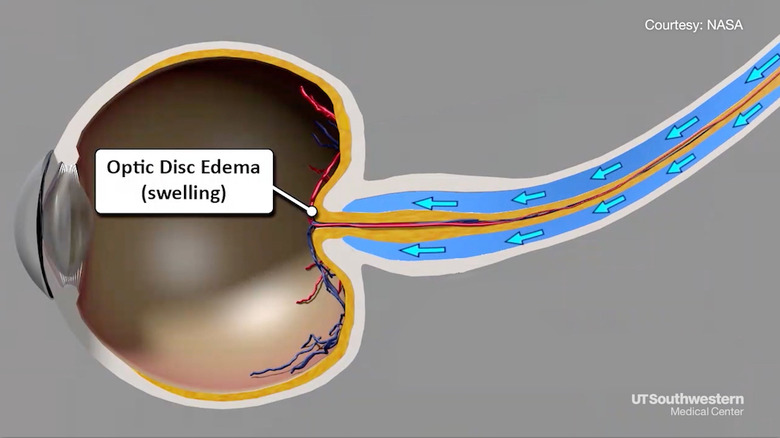Why NASA's Mars Astronauts May Need To Sleep In Suction Bags
A new study from UT Southwestern Medical Center sheds light on an eye condition that impacts astronauts in space, as well as a unique "sleeping bag" that uses suction technology to mitigate the problem. The innovation, which resembles a cone-shaped machine, is designed to pull fluid away from an astronaut's head when they sleep, preventing fluid from damaging eye structures.
The problem
Space is hard on the body, which is why NASA and a number of other entities have spent substantial amounts of time and effort to better understand the effects (via USRA). A number of technologies are already in place on the International Space Station that helps astronauts mitigate some of the health issues that result from living in a microgravity environment, including exercise equipment (via NASA).
Astronauts are required to have perfect vision, but over the years, NASA noticed their eyesight had worsened after returning to Earth following time spent living on the ISS. The space agency tapped UT Southwestern to study the root cause of the problem and develop a way to prevent it altogether. The results were recently published in JAMA Opthalmology, revealing that fluid build-up in the head may damage delicate eye structures over relatively short periods of time.

Put simply, fluid naturally travels to one's head while lying down, but gravity ensures it doesn't stay there once a person gets up in the morning and starts their day. Things are different on the ISS, however, where astronauts float around in a microgravity environment.
The lack of gravity means fluid can build up in an astronaut's head but won't naturally flow away from it later on. This phenomenon can lead to a spaceflight-related vision disorder called neuro-ocular syndrome (SANS), according to UT Southwestern, which describes it as a "progressive flattening" of an astronaut's eyes.
The optic nerve, researchers found, will swell over time due to this fluid pressure, leading to gradual vision damage. Multiple NASA astronauts have experienced vision changes after spending at least half a year on the ISS, some of which were substantial enough to impact their ability to perform experiments and read materials while in space.
The researchers say the fluid changes may also lead to other health complications over time, including some that haven't been identified yet. Fortunately, however, at least some SANS vision changes return may return to normal once the astronauts return to Earth.
Sleeping bag solution
The solution to this fluid build-up problem may be a specially-designed sleeping bag, according to UT Southwestern, which has teamed up with REI, a retailer that sells outdoor equipment. The space upgrade involved building a solid frame for the sleeping bag; when in use, the frame fits around the astronaut's waist. The sleeping bag capsule is sealed and vacuum technology is used to draw fluid from the head, relieving pressure on the brain and eyes.
Multiple people tested the technology, including the university's Dr. James Leidner. The experiment involved spending long periods of time lying flat in bed so that fluid could build up in the participant's head, then spending eight hours at night sleeping in the unique bag.
NASA still needs some answers about the promising technology, including how much time astronauts should spend using it to prevent fluid-related problems. However, the innovation may one day be used as part of the standard equipment included in spaceflight, particularly for future long-term manned missions to Mars.
